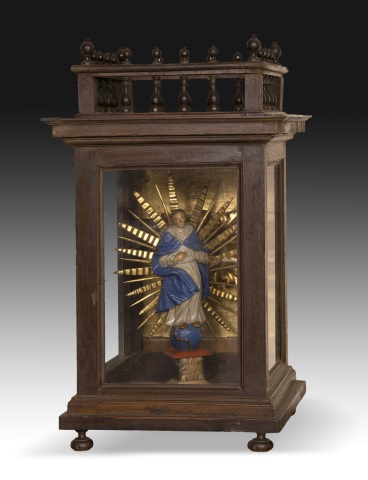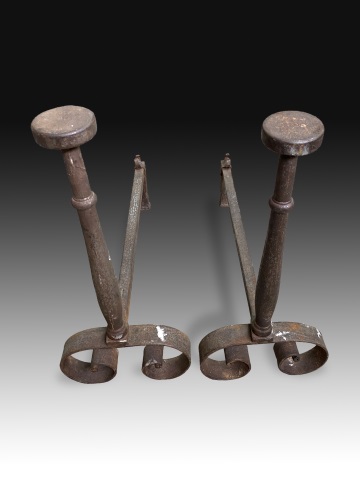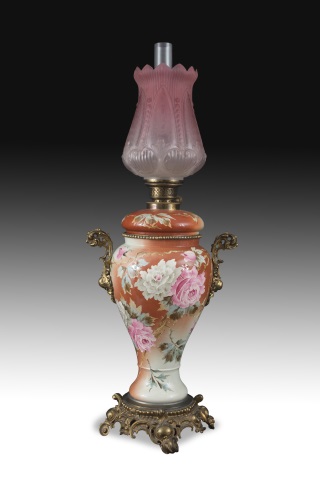
-
Bottle rack. Polychrome iron. 20th century. Tall cabinet with curved legs and double doors at the front, with iron shelves (double wires on each “shelf”) for storing bottles. It is decorated with curved rods accompanied by bunches of grapes at the front, and a simple trellis on the other sides of the cabinet, as well as crests and curves at the top.
· Size: 85x46x190 cms.
DECORATIVE ANTIQUES
MISCELLANEUS
Ref.: ZE250
-
A flat octagonal box with a key lock and decorated with magnificent marquetry. On the lid, the decorative plant elements are arranged around a very delicate central motif; on the sides, a band with symmetrical plant elements has been arranged under another band of very elegant and simple geometric motifs, so as not to overshadow the former. The motifs on the box are reminiscent of Boulle-type marquetry due to their delicacy and design.
· Size: 53x53x18 cms.
DECORATIVE ANTIQUES
MISCELLANEUS
Ref.: Z0516
-
Anatomical model of the skeletal system. Circa 1950. On a square base and supported by a metal rod stands the skeleton, an anatomical model of human bones widely used since the 18th century in Faculties and Schools of Surgery, Medicine, etc.
· Size: 35x35x160 cms.
DECORATIVE ANTIQUES
MISCELLANEUS
Ref.: Z2676
-
Fire hose cart. Possibly around the first third of the 20th century. A two-wheeled hose cart, typically pulled by firefighters when needed, also has a front box for storing tools, hose heads, and metal parts for use with the hose, as well as another auxiliary hose.
· Size: 220x130x102 cms
DECORATIVE ANTIQUES
MISCELLANEUS
Ref.: Z1009B
-
Mahogany brazier box, 18th century. The box stands on claw-shaped legs with balls. It has a circular profile and is decorated with mixed-linear skirts at the bottom and nails with plant elements at the top. The central hollow contains the container for the coal, which has two handles decorated with scallops. This type of furniture was widely used in homes as a heating system or to purify the air (by burning olive stones), varying in type and decoration according to the importance of the family.
· Size: 87x87x20 cms.
DECORATIVE ANTIQUES
MISCELLANEUS
Ref.: Z0446
-
Chapel. Walnut wood. 17th century. Chapel for a private oratory made of carved walnut and decorated with architectural elements inspired by classicism (split triangular pediment, mouldings, etc.) but with a clear relationship with the Baroque, as well as certain touches that recall Italian examples (particularly the columns with carved undulations). The importance of classicism and the predominance of a simple architectural composition were common in Spanish Baroque altars, along with other more exuberant ones.
· Size: 80x14x115 cms.
DECORATIVE ANTIQUES
MISCELLANEUS
Ref.: Z0607
-
Two bronze candlesticks. 20th century. Two almost identical bronze candlesticks with a triangular base on legs (these with plant elements ending in claws holding balls) and a vase-shaped shaft ending in a disk from which the piece for the candle starts. In some details it is reminiscent of 17th century Baroque examples, while in others it is more similar to later examples. This mixture of styles was common in 19th century art. Weight: 12 kg.
· Size: 21x20x63 cms.
DECORATIVE ANTIQUES
MISCELLANEUS
Ref.: Z0413A
-
Ewer with bowl. Glazed porcelain. Mortiz Zdekauer, Altrohlau, Czech Republic, late 19th century. With marks on the base. Set of a washbasin and a tray decorated with bands of floral plant elements in bright blue, red and gold tones. The centre of the washbasin features a hand-painted female figure, present in many of the factory's works, which may have been made by an artist called Asti. The tray shows two other tondos with female portraits, following the same style. The markings on the base identify the piece as being made in the Moritz Zdekauer factory in Altrohlau (now in the Czech Republic, but formerly part of the Habsburg Empire). It was in operation between 1884 and 1909, changing its brand to MZ Altrolau from this date, continuing its work until 1945, being nationalised after the Second World War, continuing under the name Starorolsky Porcelan Mortiz Zdekauer.
· Size: 48x8x42 cms.
DECORATIVE ANTIQUES
MISCELLANEUS
Ref.: ZF0023
-

Chapel of the Immaculate Conception. Sculpture, carved wood, glass, metal. Second half of the 18th century. A carved wooden chapel with decoration on the upper part of the railing and balusters in the shape of a vase reminiscent of the Baroque, which has three of its four fronts in transparent glass and stands slightly on circular legs. Inside, one can see a gold background (on the fourth front of the chapel, highlighting a carved and polychrome plant composition), and a polychrome sculpture of the Immaculate Conception surrounded by alternating flat and wavy and pointed and circular rays of light. The carving stands on a pedestal, and has a white tunic and a blue cloak; Mary stands on the Orb of Creation, in which a snake appears (linked to Sin). The carving shows a clear influence from Spanish Baroque models, as well as certain details such as the posture that can be linked to Neoclassicism. This mixture and the maintenance of the Baroque influence are common in 18th century Spanish sculpture.
· Size: 38,5x38x65 cms virgen
DECORATIVE ANTIQUES
MISCELLANEUS
Ref.: Z0252
-
Pair of paired pilasters. Carved, polychrome and gilded mother. 17th century. Pair of mouldings made of carved, polychrome and gilded wood, composed of paired pilasters, curves, etc., and decorated with architectural elements with a marked classicist influence and clean lines. The lines shown in their profiles link them to the Baroque.
· Size: 17x12x74 cms.
DECORATIVE ANTIQUES
MISCELLANEUS
Ref.: Z2511
-
Window frame. Carved stone. 20th century. Window frame made of carved stone in its colour, decorated with scrolls and bands with knots reminiscent of Celtic tradition, as well as a checkerboard pattern that can be linked to examples of Spanish Romanesque among other styles, and scrolls of classical influence. These types of pieces have been made since ancient times to enhance openings in prominent homes.
· Size: 108x114 cms. int 51x100 cms.
DECORATIVE ANTIQUES
MISCELLANEUS
Ref.: Z5657
-
Special Offer! - Off

Pair of fireplace andirons. Iron. 19th century. A pair of iron fireplace andirons, each consisting of a horizontal piece to be placed under the firewood and a decorative front section (comprising a rectangular plate ending in two opposing volutes and a vertical piece resembling a column, topped with a flat disc). While elements such as the volutes appear in Romanesque ironwork, the lines of the andirons are more reminiscent of Neoclassical examples in some details.
· Size: 32x80x70 cms.
DECORATIVE ANTIQUES
MISCELLANEUS
Ref.: Z5802
-
Votive lamp. Bronze. 18th century. Bronze lamp for lighting with oil and candles, of the type usually used in churches, hanging from vaults, arches, etc. Sometimes, and especially when made of silver, they are known as tabernacle lamps because this is their usual location. The shape and decorative elements of this piece refer to models with a certain Neoclassical influence, maintaining details more common in Baroque models of the 17th century.
· Size: 45x45x120 cms.
DECORATIVE ANTIQUES
MISCELLANEUS
Ref.: Z0707
-
Set of three heraldic plaques. Bronze. 18th century. Bronze plaques decorated with a castle with a pelican pecking at its chest at the door, a heraldic element enhanced with symmetrically arranged plant forms. Although the pelican appears in heraldry with some frequency, it is possible that the pieces are related to the surname Lázaro.
· Size: 23,5x0.2x25 cms
DECORATIVE ANTIQUES
MISCELLANEUS
Ref.: Z2265
-
Special Offer! - Off

Gas lamp in glass, gilt bronze and enameled porcelain. 19th century A pedestal adorned with rocaille and medallions serves as the base for the porcelain vase decorated with roses, which forms the body of the lamp and features two metal handles. The top houses the valve for controlling the gas flow, and the flame is protected by a glass cylinder encased in a carved, pink glass flower. While not neglecting the functionality of these pieces, considerable time and effort have been dedicated to the decorative aspects, as this lamp is intended for a prestigious interior.
· Size: 30x30x85 cms.
DECORATIVE ANTIQUES
MISCELLANEUS
Ref.: Z6222
-
Bronze bell. India, 20th century. Bell made of bronze with a tall, oval body at the base, almost rectangular in height, which has an elaborate upper part with smooth areas and figures of the same material. In addition to these, it has been decorated with fine reliefs with geometric and plant themes concentrated in certain areas throughout the piece.
· Size: 47x47x100 cms
DECORATIVE ANTIQUES
MISCELLANEUS
Ref.: ZF0859
-
Spice rack. Silver. Spain, 20th century. With contrast markings. An oval-shaped, scalloped vessel supported by four legs, featuring a human head with outstretched wings and an architecturally designed base decorated with vegetal motifs in a distinctly classical style. Stylistically, it draws inspiration from antique Spanish silverwork. The star hallmark reserved for sterling silver according to the 1935 regulations is visible, as well as an unidentified silversmith's mark.
· Size: 12,5x11x11,5 cms
DECORATIVE ANTIQUES
MISCELLANEUS
Ref.: ZF1375
-
17th century Transformed into a bracket.
· Size: 38,5x26x15 cms.
DECORATIVE ANTIQUES
MISCELLANEUS
Ref.: Z0668
-
Two-leaf door with castanet frame. Pine wood. Spain, 17th century. Double-leaf door made of pine wood decorated with rectangular panels arranged in rows and a castanet-type frame (named after the elements that decorate it). Although panels were a common element in the Renaissance, they continued to be used in this period and long after.
· Size: Puertas 177x94,5 cms c/Marco 184x107 cms.
DECORATIVE ANTIQUES
MISCELLANEUS
Ref.: Z0696
-
Pair of wall lights. Bronze, glass. Empire style, France, circa 1900. Both are practically identical, each wall lamp has three points of light and a decoration and lines that respond to the classicist influence of the style to which they belong. Note the palms, the scrolls, the smooth mouldings, etc. These types of lighting elements were common in prominent interiors.
· Size: 34x22x52 cms.
DECORATIVE ANTIQUES
MISCELLANEUS
Ref.: Z0776
-
"
· Size: 40x27x52 cms.
DECORATIVE ANTIQUES
MISCELLANEUS
Ref.: Z0777
-
Three volumes, God and his works (…). Barcelona, J. Verdaguer, 1843 and 1841. Set of three bound volumes matching (with title and numbers 1, 2 and 4 on the spine) the books: -God and his works. Album of 230 very fine open steel plates. Complement to those accompanying the Picturesque Dictionary of Natural History. (…) Barcelona, J. Verdaguer Printing House, 1843. -Album of quadrupeds. Collection of 148 open steel plates for the illustration of the Picturesque Dictionary of Natural History. Barcelona, J. Verdaguer Printing House, 1841. -God and his works. Bird album. Collection of 188 open steel plates for the illustration of the Picturesque Dictionary of Natural History. Barcelona, J. Verdaguer Printing House, 1841.
· Size: 15x12x22 cms
DECORATIVE ANTIQUES
MISCELLANEUS
Ref.: Z2223
-
Alembic. Iron and copper trivet. 19th century. A still with a globular body with four handles made of another metal and an elongated neck, which has a lid and a pipe to expel the condensed liquid after distillation.
· Size: 115x80x125 cms.
DECORATIVE ANTIQUES
MISCELLANEUS
Ref.: Z3693
-
Blacksmith's bellows. Pine wood, wrought iron, leather. 18th century. Bellows made of carved pine wood and reinforced wrought iron and completed with leather and studs.
· Size: 175x90x25 cms.
DECORATIVE ANTIQUES
MISCELLANEUS
Ref.: Z5658